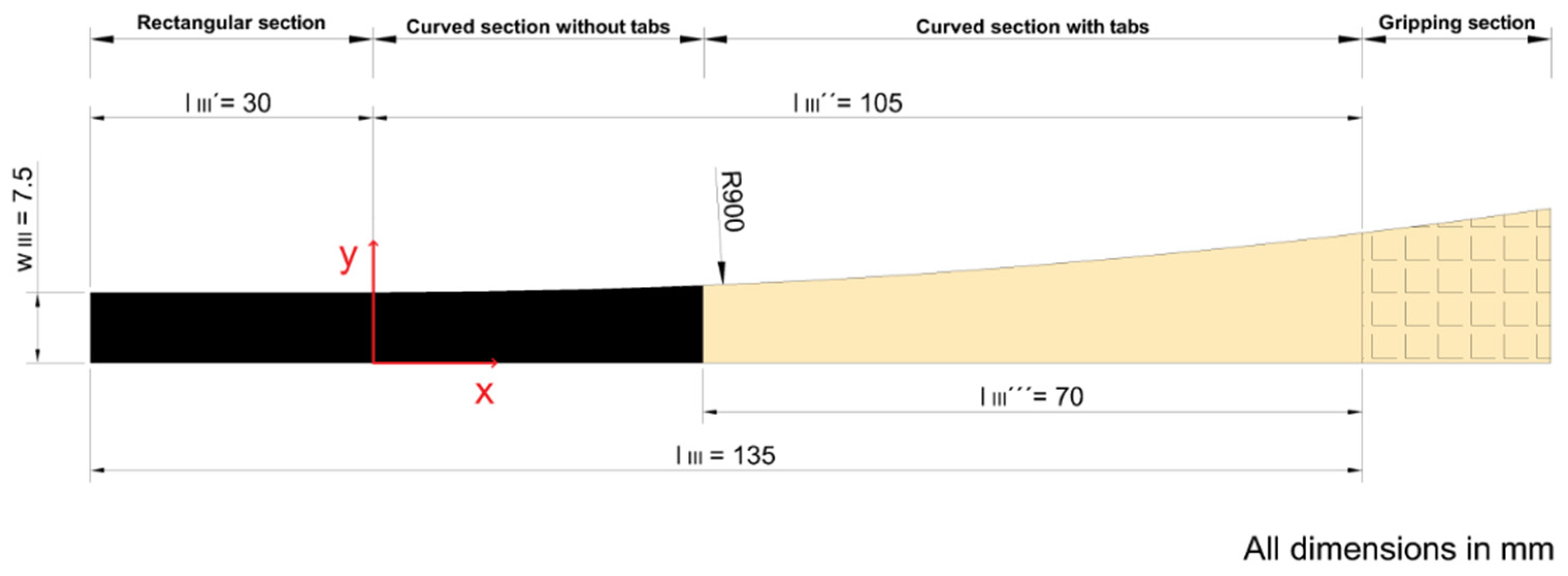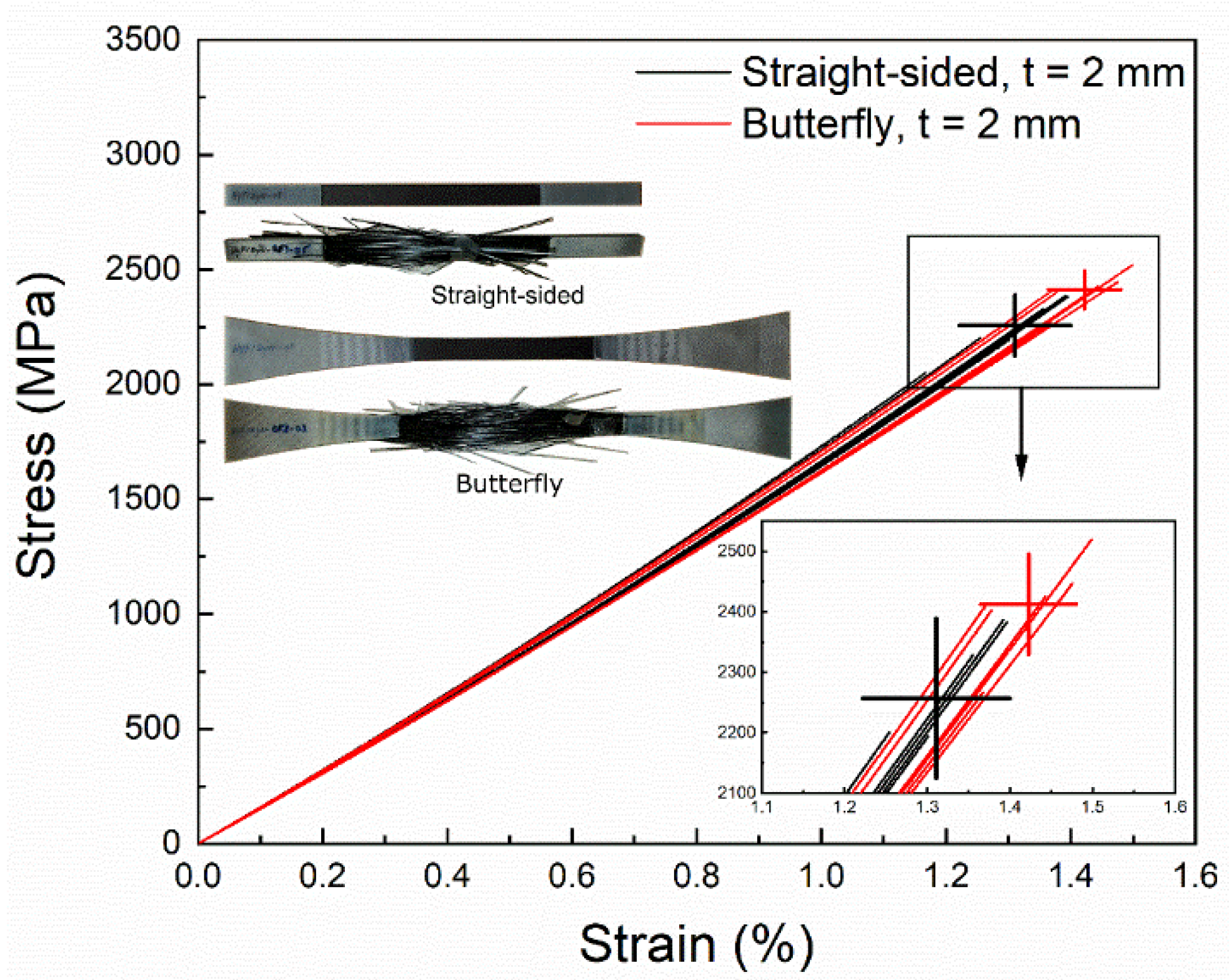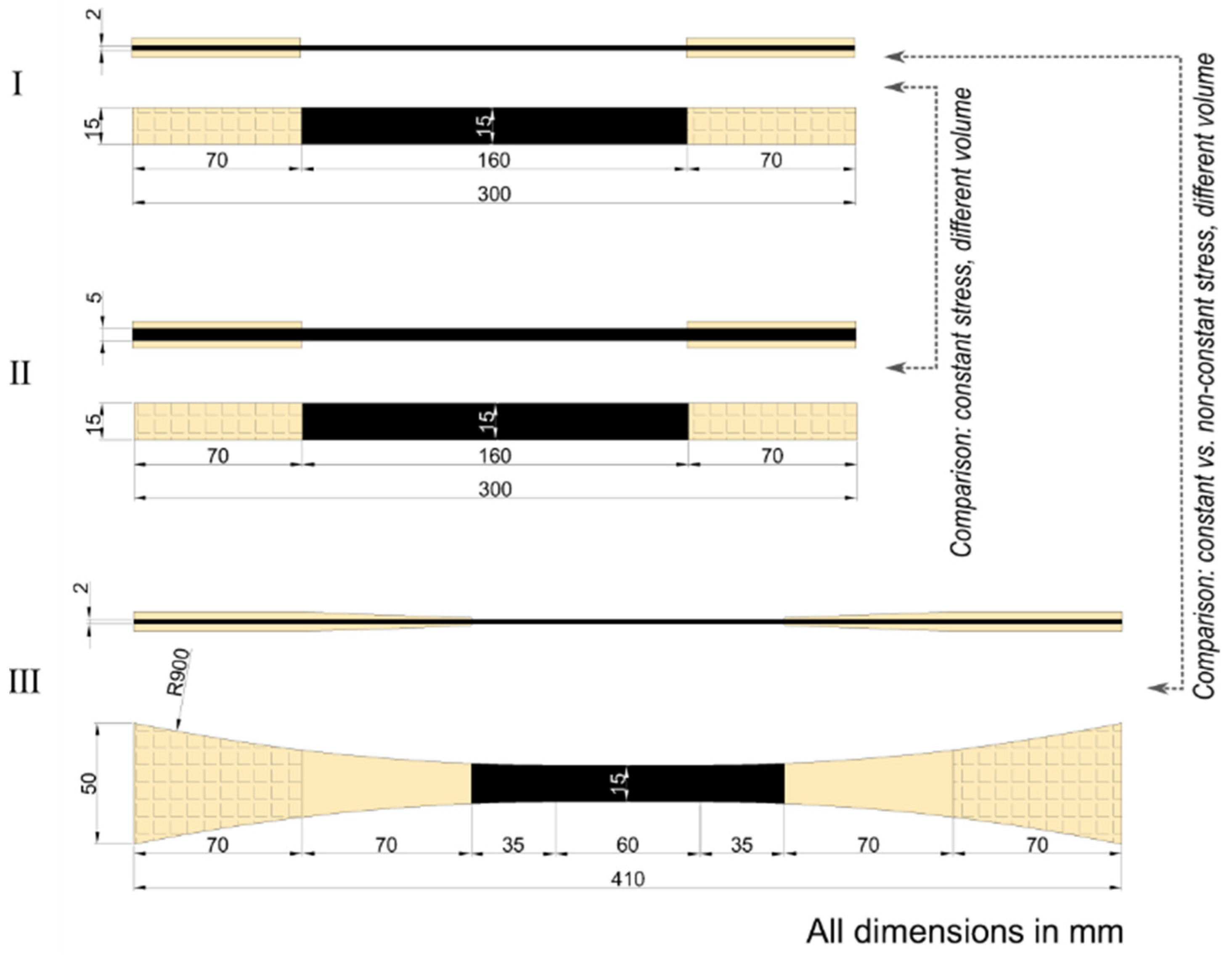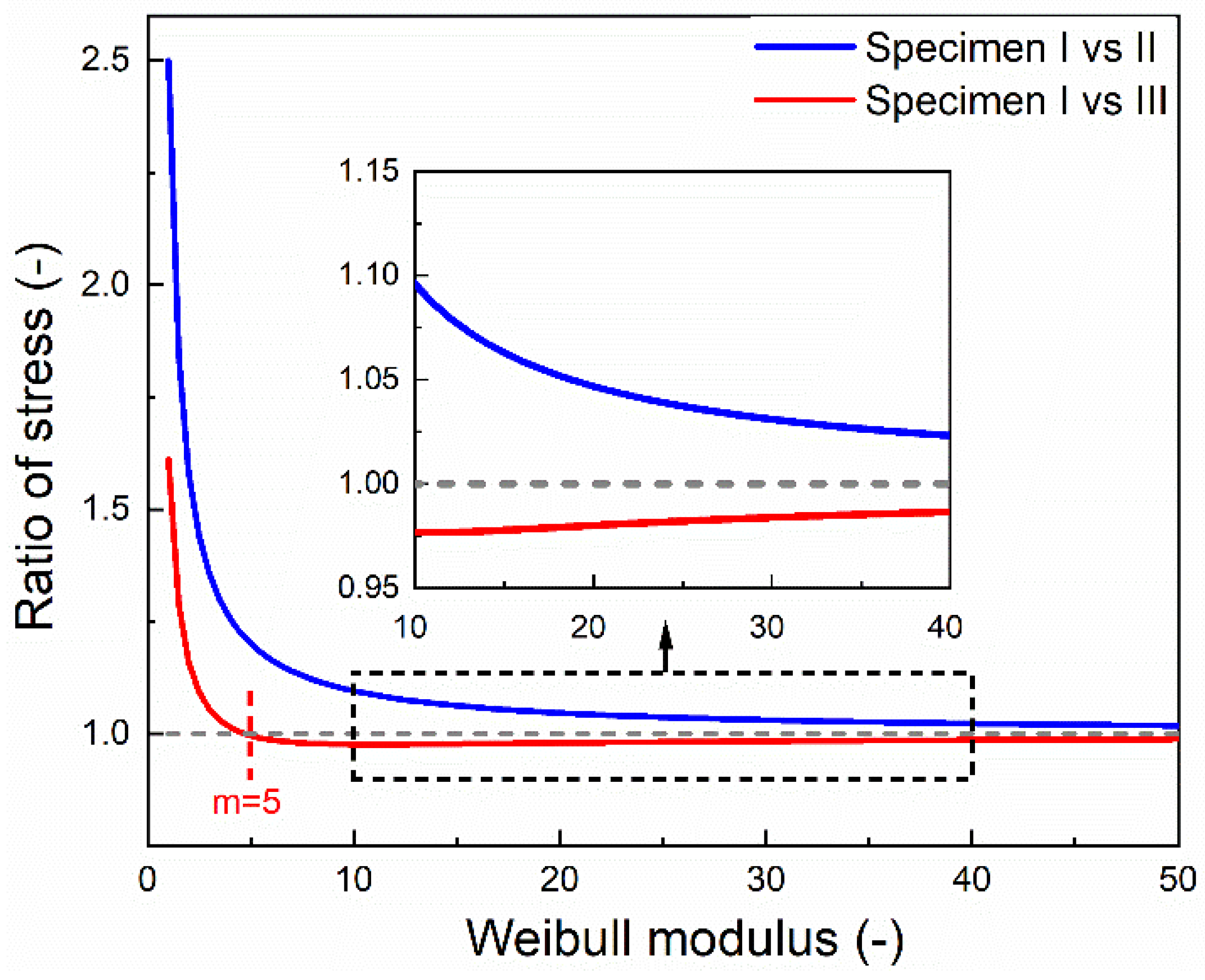Influence of Test Specimen Geometry on Probability of Failure of Composites Based on Weibull Weakest Link Theory
Abstract
:1. Introduction
2. Motivation
3. The Weibull Model for the Probability of Failure
3.1. Test Specimens
- Straight-sided specimen, based on standard ISO 527-5:2009 [21]; thickness , cross-sectional area , tested volume .
- Straight-sided specimen, based on standard ISO 527-5:2009 [21]; thickness , cross-sectional area , tested volume .
- Non-straight-sided specimen, butterfly-shaped, designed at DTU Wind Energy [14]; thickness , cross-sectional area in the range , tested constant stress volume , tested non-constant stress volume .
3.2. Comparison between Constant Stress Specimens
3.3. Comparison between Constant vs. Non-Constant Stress Specimens

4. Conclusions
Author Contributions
Funding
Institutional Review Board Statement
Informed Consent Statement
Data Availability Statement
Conflicts of Interest
References
- Bazant, Z.P.; Chen, E.P. Scaling of structural failure. Appl. Mech. Rev. 1997, 50, 593–627. [Google Scholar] [CrossRef]
- Hu, X.; Duan, K. Size effect and quasi-brittle fracture: The role of FPZ. Int. J. Fract. 2008, 154, 3–14. [Google Scholar] [CrossRef]
- Gao, X.; Koval, G.; Chazallon, C. Energetical formulation of size effect law for quasi-brittle fracture. Eng. Fract. Mech. 2017, 175, 279–292. [Google Scholar] [CrossRef]
- Hu, X.; Guan, J.; Wang, Y.; Keating, A.; Yang, S. Comparison of boundary and size effect models based on new developments. Eng. Fract. Mech. 2017, 175, 146–167. [Google Scholar] [CrossRef]
- Wisnom, M.R. Relationship between strength variability and size effect in unidirectional carbon fibre/epoxy. Composites 1991, 22, 47–52. [Google Scholar] [CrossRef]
- Sørensen, B.F.; Toftegaard, H.; Linderoth, S.; Lundberg, M.; Feih, S. Strength and failure modes of ceramic multilayers. J. Eur. Ceram. Soc. 2012, 32, 4165–4176. [Google Scholar] [CrossRef]
- Lei, W.-S. A generalized weakest-link model for size effect on strength of quasi-brittle materials. J. Mater. Sci. 2018, 53, 1227–1245. [Google Scholar] [CrossRef]
- Lei, W.S.; Qian, G.; Yu, Z.; Berto, F. Statistical size scaling of compressive strength of quasi-brittle materials incorporating specimen length-to-diameter ratio effect. Theor. Appl. Fract. Mech. 2019, 104, 102345. [Google Scholar] [CrossRef]
- Weibull, W.A. Statistical Theory of the Strength of Materials; Royal Swedish Academy of Engineering Sciences: Stockholm, Sweden, 1939. [Google Scholar]
- Bullock, R.E. Strength Ratios of Composite Materials in Flexure and in Tension. J. Compos. Mater. 1974, 8, 200–206. [Google Scholar] [CrossRef]
- Wisnom, M.R.; Khan, B.; Hallett, S.R. Size effects in unnotched tensile strength of unidirectional and quasi-isotropic carbon/epoxy composites. Compos. Struct. 2008, 84, 21–28. [Google Scholar]
- Maheri, M.R. An improved method for testing unidirectional FRP composites in tension. Compos. Struct. 1995, 33, 27–34. [Google Scholar] [CrossRef]
- Matsuo, T.; Hojo, M.; Kageyama, K. Influence of gripping method on tensile properties of unidirectional thermoplastic CFRP—Round-robin activity for international standardization in Japan. J. Compos. Mater. 2019, 53, 4161–4171. [Google Scholar] [CrossRef]
- Korkiakoski, S.; Brøndsted, P.; Sarlin, E.; Saarela, O. Influence of specimen type and reinforcement on measured tension-tension fatigue life of unidirectional GFRP laminates. Int. J. Fatigue 2016, 85, 114–129. [Google Scholar] [CrossRef] [Green Version]
- De Baere, I.; Van Paepegem, W.; Hochard, C.; Degrieck, J. On the tension–tension fatigue behaviour of a carbon reinforced thermoplastic part II: Evaluation of a dumbbell-shaped specimen. Polym. Test. 2011, 30, 663–672. [Google Scholar] [CrossRef] [Green Version]
- Kumar, R.; Mikkelsen, L.P.; Lilholt, H.; Madsen, B. Experimental Method for Tensile Testing of Unidirectional Carbon Fibre Composites Using Improved Specimen Type and Data Analysis. Materials 2021, 14, 3939. [Google Scholar] [CrossRef] [PubMed]
- Ueki, Y.; Lilholt, H.; Madsen, B. Fatigue behaviour of uni-directional flax fibre/epoxy composites. In Proceedings of the 20th International Conference on Composite Materials ICCM20 Secretariat, Copenhagen, Denmark, 19–24 July 2015. [Google Scholar]
- Wisnom, M.R. Size effects in the testing of fibre-composite materials. Compos. Sci. Technol. 1999, 59, 1937–1957. [Google Scholar] [CrossRef]
- Bunsell, A.R.; Renard, J. Fundamental of Fibre Reinforced Composite Materials; Institute of Physics Series in Materials Science and Engineering: Bristol, UK; Institute of Physics Publishing: Philadelphia, PA, USA, 2005. [Google Scholar]
- Hademenos, G.J.; Spiegel, M.R. Mathematical Handbook of Formulas and Tables: Based on Schaum’s Outline of Mathematical Handbook of Formulas and Tables; McGraw-Hill: New York, NY, USA, 2001. [Google Scholar]
- ISO 527-5:2009; Plastics—Determination of Tensile Properties—Part 5: Test Conditions for Unidirectional Fibre-Reinforced Plastic Composites. ISO: Geneva, Switzerland, 2009.
- Mikkelsen, L.P.; Kumar, R. Probability of failure in composites: Influence of test specimen design [Software]. Zenodo 2021. [Google Scholar] [CrossRef]
- Giannadakis, K.; Mannberg, P.; Joffe, R.; Varna, J. The sources of inelastic behavior of Glass Fibre/Vinylester non-crimp fabric [±45]s laminates. J. Reinf. Plast. Compos. 2011, 30, 1015–1028. [Google Scholar] [CrossRef]



Publisher’s Note: MDPI stays neutral with regard to jurisdictional claims in published maps and institutional affiliations. |
© 2022 by the authors. Licensee MDPI, Basel, Switzerland. This article is an open access article distributed under the terms and conditions of the Creative Commons Attribution (CC BY) license (https://creativecommons.org/licenses/by/4.0/).
Share and Cite
Kumar, R.; Madsen, B.; Lilholt, H.; Mikkelsen, L.P. Influence of Test Specimen Geometry on Probability of Failure of Composites Based on Weibull Weakest Link Theory. Materials 2022, 15, 3911. https://doi.org/10.3390/ma15113911
Kumar R, Madsen B, Lilholt H, Mikkelsen LP. Influence of Test Specimen Geometry on Probability of Failure of Composites Based on Weibull Weakest Link Theory. Materials. 2022; 15(11):3911. https://doi.org/10.3390/ma15113911
Chicago/Turabian StyleKumar, Rajnish, Bo Madsen, Hans Lilholt, and Lars P. Mikkelsen. 2022. "Influence of Test Specimen Geometry on Probability of Failure of Composites Based on Weibull Weakest Link Theory" Materials 15, no. 11: 3911. https://doi.org/10.3390/ma15113911
APA StyleKumar, R., Madsen, B., Lilholt, H., & Mikkelsen, L. P. (2022). Influence of Test Specimen Geometry on Probability of Failure of Composites Based on Weibull Weakest Link Theory. Materials, 15(11), 3911. https://doi.org/10.3390/ma15113911





